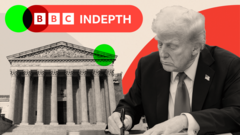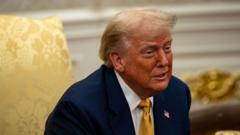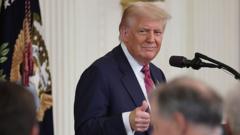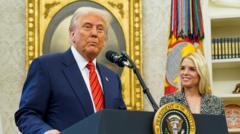Trump's use of the judicial system reflects a significant transformation in the balance of power, as recent Supreme Court decisions bolster his position against dissenting judges, raising questions about the implications for democracy.**
The Courtroom Battle: Trump’s Fight for Power and Its Consequences**

The Courtroom Battle: Trump’s Fight for Power and Its Consequences**
Examining how Donald Trump's legal challenges are not just personal but symptomatic of broader shifts in presidential authority.**
It was a warm, unassuming day in May 2024 when the outcome of Donald Trump's trial over hush money payments to Stormy Daniels began making headlines. A fervent anticipation enveloped lower Manhattan as jurors weighed the gravity of the situation, ultimately returning with shocking guilty verdicts on all charges against the former president, marking a notable first in U.S. history.
As the coverage unfolded, Trump's shadow loomed large over multiple court cases across the East Coast. Legal battles added up swiftly, with numerous civil and criminal charges threatening his political future. Fast forward a year, the former president’s fortunes appear to have shifted dramatically, emboldened by recent Supreme Court rulings. These decisions appear to grant sweeping immunity to Trump and significantly empower the executive branch—partly due to Trump’s consolidation in the court system with a conservative majority.
Trump’s administration has directed sharp criticisms towards federal district judges, accusing them of hindering his agenda. This has prompted discussions about whether these judges should retaliate—particularly given the unprecedented pressure they face. The alarming trend has raised concerns about the health of the judicial system and the possibility of long-term shifts in executive power.
Several judges, both current and retired, have likened the current environment to an outright assault on judicial independence. Observers are increasingly wary of the rhetoric surrounding judicial legitimacy. Trump’s confrontations with the courts have transformed into a unique phenomenon, filled with accusations of tyranny against judges perceived as obstacles to his policy goals.
Judge Nancy Gertner underscored the severity of this crisis, highlighting that those in public service increasingly confront threats of violence spurred by hostile political commentary. Evidence suggests that ongoing intimidation and threats against judges have surged, with more than 400 reports of danger documented in the first part of the year.
In the context of executive orders, Trump has taken a controversial route by issuing a barrage of directives, some of which have incited judicial pushback. These executive decisions, while within his rights as outlined in the Constitution, often grapple with constitutional boundaries, sparking numerous legal challenges.
Contentious battles in the courts have raised fundamental questions about the rule of law and the democratic system. Critics charge that Trump’s administration is rewriting the nature of checks and balances and altering the fabric of governance itself. Prominent constitutional scholars have voiced concerns that the nation may face dire consequences if the current trajectory continues.
With judges asserting themselves against this administration and mounting legal battles continuing unabated, the ongoing struggle between Trump's agenda and the judiciary raises serious questions about the future. Many ponder whether the judiciary can recover its respect and authority in a political environment increasingly riddled with strained relationships and erratic confrontation. The unfolding scenario promises to shape U.S. governance for years to come.






















